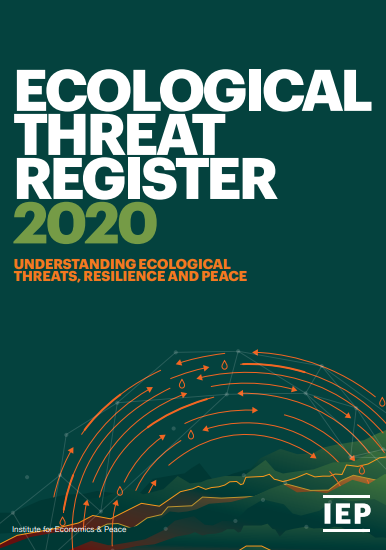Countries facing the highest number of ecological threats are among the world’s least peaceful countries
- September 17, 2020
- Posted by: administrator
- Category: Global, Reports, Water Issues

The inaugural edition of the Ecological Threat Register (ETR), which covers 157 independent states and territories is warning that countries facing the highest number of ecological threats are among the world’s least peaceful countries
The ETR measures ecological threats that countries are currently facing and provides projections to 2050.
The Register analyses population growth, water stress, food insecurity, droughts, floods, cyclones, rising temperatures and sea levels. The ETR is unique in that it combines measures of resilience with the most comprehensive ecological data available to shed light on the countries least likely to cope with extreme ecological shocks, now and into the future. Key findings include:
- 19 countries with the highest number of ecological threats are among the world’s 40 least peaceful countries including Afghanistan, Syria, Iraq, Chad, India and Pakistan.
- By 2040, a total of 5.4 billion people – more than half of the world’s projected population – will live in the 59 countries experiencing high or extreme water stress, including India and China.
- Over one billion people live in 31 countries where the country’s resilience is unlikely to sufficiently withstand the impact of ecological events by 2050, contributing to mass population displacement.
- Sub-Saharan Africa, South Asia, the Middle East and North Africa are the regions facing the largest number of ecological threats.
- 5 billion people could suffer from food insecurity by 2050 – an increase of 1.5 billion people from today.
The lack of resilience in countries covered in the ETR will lead to worsening food insecurity and competition over resources, increasing civil unrest and mass displacement, exposing developed countries to increased influxes of refugees.
By 2040 5.4 billion people – more than half of the world’s projected population – will live in 59 countries experiencing high or extreme water stress
According to the report, of the 157 countries covered in the ETR, 34 per cent will face catastrophic water stress and 22 per cent face catastrophic food insecurity by 2050. As a result, there will be substantial displacement of people or a substantial increase in undernourishment.
In addition, it is estimated that the combined effects of rising temperatures, population growth and increased rainfall variability are likely to reduce the water supply in many countries.
Currently more than 2.6 billion people are living in the 46 countries currently experiencing high or extreme water stress. However, by 2040, a total of 5.4 billion people – or more than half of the world’s projected population – will live in the 59 countries experiencing high or extreme water stress.
Commenting on natural disasters globally, according to the ETR the frequency of natural disasters has increased ten-fold since 1960 – increasing from 39 incidents in 1960 to 396 in 2019. From 1990 to 2019, a total of 9,924 natural disasters occurred globally, of which 42 per cent were floods.
In 2019, natural disasters displaced 25 million people – which was three times higher than the 8.6 million displaced by armed conflict. However, at current rates, 1.2 billion people could be displaced globally by 2050 due to natural disasters and armed conflict.
The ETR is warning that the world’s least resilient countries, when faced with ecological breakdowns, are more likely to experience civil unrest, political instability, social fragmentation and economic collapse. However, ecological and humanitarian crises often spill over across international borders, increasing the likelihood of civil unrest and political instability in adjacent countries.
Currently, more than one billion people live in countries that are unlikely to have the ability to mitigate and adapt to new ecological threats.
The report is recommending that to reduce the impact of future ecological shocks, it is important to increase the levels of resilience in the most vulnerable countries. This will enable countries to be better prepared for shocks, but also to have stronger capabilities to deal with the after effects of these shocks.
High resilience regions, such as Europe and North America, have superior coping capacities to mitigate the effects of these ecological threats, but they will not be immune from large flows of refugees. Building resilience to ecological threats will increasingly become more important and will require substantial investment today.
Click here to download the Ecological Threat Register September 2020
